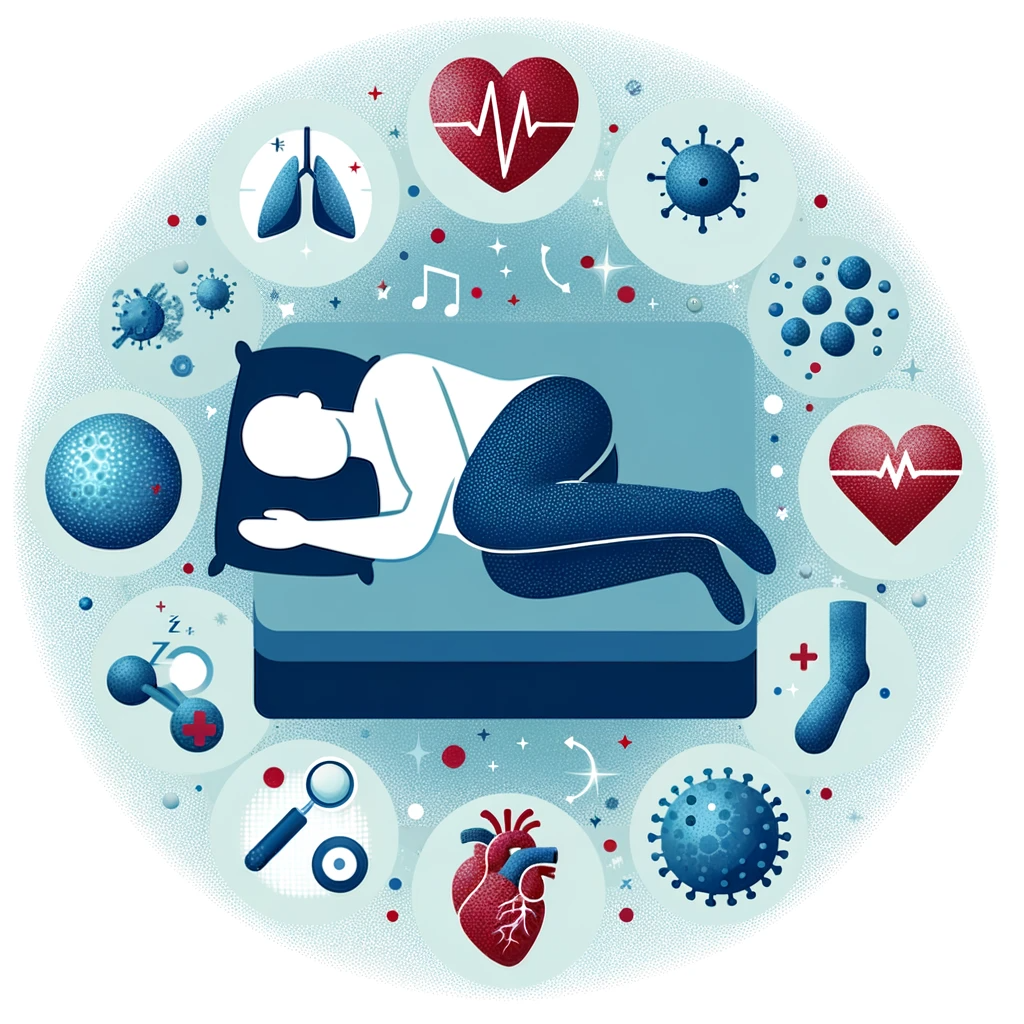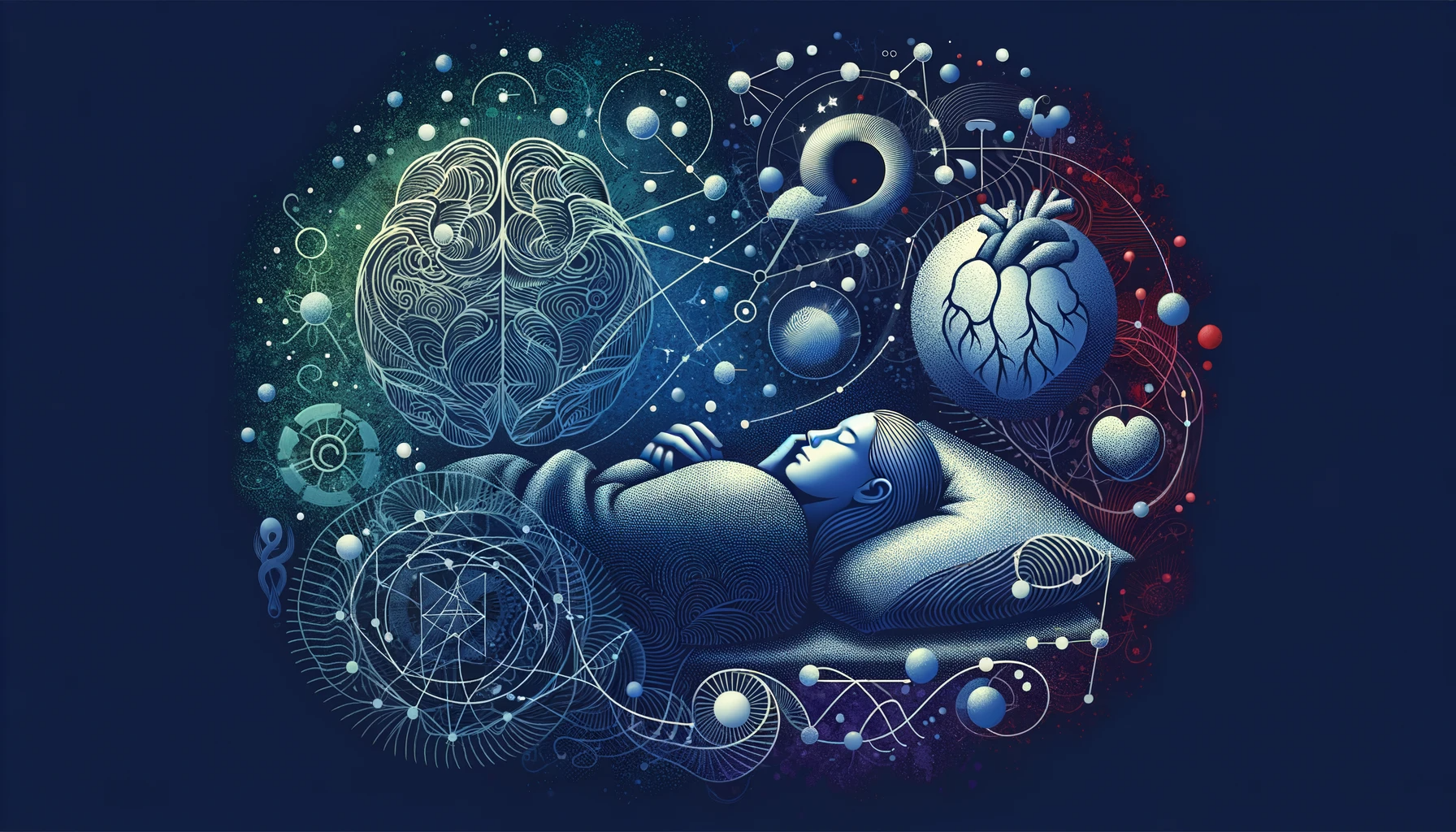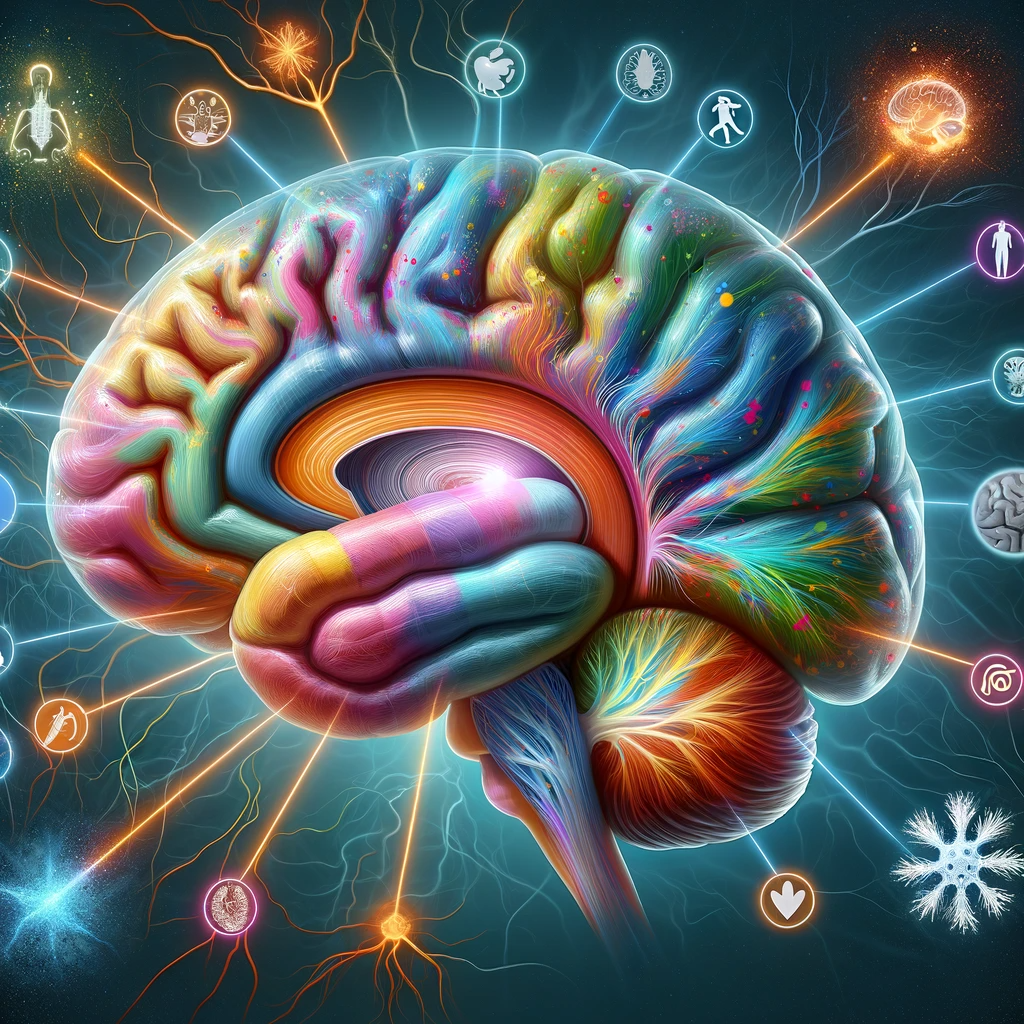In our fast-paced world, sleep is often the first sacrifice we make to meet the demands of our busy lives. However, the science behind sleep reveals its critical role in our overall health and well-being. This article offers an in-depth look at the neuroscience of sleep, its various stages, and how it profoundly influences our mental and physical health.
The Neuroscience of Sleep

Sleep is a complex and dynamic process that is crucial for our brain’s health and overall well-being. Contrary to the old belief that the brain simply “shuts off” during sleep, it’s actually engaged in a number of vital activities. The neuroscience of sleep involves a sophisticated interplay of brain structures, neural networks, and neurotransmitters.
- Role of the Hypothalamus: The hypothalamus, a peanut-sized structure deep within the brain, is pivotal in sleep regulation. It contains clusters of nerve cells that act as control centers for sleep and wakefulness. These centers receive signals about light exposure directly from the eyes and adjust the body’s internal clock accordingly. The suprachiasmatic nucleus (SCN), located within the hypothalamus, is particularly important as it’s responsible for controlling circadian rhythms (Saper, Scammell, & Lu, 2005).
- Function of the Brain Stem: The brain stem, connecting the brain to the spinal cord, plays a critical role in the transitions between wakefulness and sleep. It houses the reticular activating system (RAS), a network of neurons that maintains a state of wakefulness. The interaction between the hypothalamus and the brain stem ensures that we transition smoothly from being awake to falling asleep (Fuller, Gooley, & Saper, 2006).
- Neurotransmitters and Sleep:
a. Adenosine: This neurotransmitter builds up in our blood throughout the day as a byproduct of cellular energy consumption. High levels of adenosine in the brain lead to sleepiness, indicating that it’s time to rest. This process is often referred to as ‘sleep pressure’ (Basheer, Strecker, Thakkar, & McCarley, 2004).
b. Melatonin: Produced in the pineal gland, melatonin is often called the ‘sleep hormone’. Its production is stimulated by darkness and inhibited by light, thereby signaling the body when it’s time to sleep. Melatonin levels start rising in the evening and peak during the night, facilitating sleep onset (Pandi-Perumal, Srinivasan, Maestroni, Cardinali, Poeggeler, & Hardeland, 2006). - Sleep Stages and Brain Activity: During sleep, the brain cycles through different stages, each characterized by unique patterns of brain waves and neuronal activity. These include Non-REM (NREM) stages 1-3 and REM (Rapid Eye Movement) sleep. NREM sleep is associated with slow brain waves, reduced heart rate, and relaxed muscles, while REM sleep features active brain patterns similar to wakefulness, rapid eye movements, and dreaming (Siegel, 2005).
Understanding the neuroscience of sleep is fundamental to appreciating its importance in our lives. Not only does it underscore the complexity of sleep as a biological process, but it also highlights how crucial quality sleep is for maintaining mental and physical health.
Stages of Sleep and Their Functions

Sleep consists of several cycles, each lasting about 90 minutes, and within each cycle, we move through four distinct stages. The first three stages are non-rapid eye movement (NREM) sleep, and the last stage is rapid eye movement (REM) sleep.
The first stage of NREM sleep is the lightest, while the third stage is the deepest. Each stage has its own specific benefits: NREM sleep is vital for physical restoration, while REM sleep, where most dreaming occurs, is crucial for cognitive functions like memory consolidation and emotional processing.
Sleep’s Impact on Mental Health

The relationship between sleep and mental health is a deeply interwoven one. Disruptions in sleep patterns can have profound effects on mental health, influencing mood, cognitive abilities, and overall psychological well-being.
- Sleep and Mood Disorders: Insufficient sleep has been strongly linked to the development and exacerbation of mood disorders. Research indicates that people with insomnia have a tenfold risk of developing depression compared to those who sleep well (Baglioni et al., 2011). Similarly, anxiety disorders are also closely tied to poor sleep, with a bidirectional relationship where each can worsen the other (Alvaro et al., 2013).
- Cognitive Functions: Sleep plays a critical role in cognitive processes such as attention, learning, memory, and decision-making. Chronic sleep deprivation impairs these functions, leading to decreased performance and alertness. REM sleep, in particular, is crucial for memory consolidation and processing emotional experiences (Walker & van Der Helm, 2009).
- Emotional Regulation: Adequate sleep is essential for emotional regulation. It’s during sleep, especially during the deep stages of NREM sleep, that our brain processes emotional information and helps regulate mood. Disrupted sleep patterns can lead to heightened emotional reactivity and difficulty in coping with stress (Goldstein & Walker, 2014).
- Sleep Hygiene and Mental Health: Practicing good sleep hygiene is not just beneficial for physical health; it’s a fundamental component of mental health. Establishing a regular sleep schedule, creating a calming bedtime routine, and ensuring a sleep-friendly environment can significantly improve sleep quality, thereby enhancing mental health.
Given the intricate link between sleep and mental health, understanding and addressing sleep issues can be a vital part of maintaining and improving mental health.
Physical Health and Sleep

Sleep is a critical factor in maintaining and improving various aspects of physical health. Its impact is extensive, affecting everything from cellular repair to systemic functions.
- Tissue Repair and Growth: During the deep stages of sleep, particularly during NREM sleep, our bodies undergo physical restoration. This period is marked by increased blood flow to muscles, which facilitates tissue growth and repair. Additionally, sleep promotes the release of growth hormone, essential for growth and development, especially in children and adolescents (Van Cauter & Plat, 1996).
- Protein Synthesis and Cellular Restoration: Sleep enhances the body’s metabolic rate, which aids in protein synthesis – a crucial process for cell repair and growth. Cellular restoration that occurs during sleep is vital for maintaining muscle health, skin integrity, and overall physiological resilience (Dattilo et al., 2011).
- Immune System Regulation: Sleep plays a pivotal role in the proper functioning of the immune system. Lack of sleep can weaken the immune response, making the body more susceptible to infections. Studies have shown that people who don’t get enough sleep are more likely to get sick after being exposed to a virus, such as the common cold virus (Cohen et al., 2009).
- Metabolic Health: Adequate sleep is crucial for maintaining metabolic health. Disruptions in sleep patterns have been linked to metabolic disorders, including obesity and diabetes. Sleep affects the regulation of hormones that control appetite, such as ghrelin and leptin, thus influencing body weight and risk of obesity (Taheri et al., 2004).
- Cardiovascular Health: Sleep quality and duration are closely linked to cardiovascular health. Chronic sleep deprivation has been associated with increased risk of heart disease, hypertension, and stroke. During sleep, blood pressure drops, and the heart rate slows, allowing the cardiovascular system to rest and recover (Mullington et al., 2009).
In conclusion, the role of sleep in physical health is multifaceted and significant. It’s not just about getting enough sleep but also ensuring its quality to support these vital bodily functions.
Tips for Improving Sleep Quality

Improving sleep quality is vital for both mental and physical health. Here are some practical tips:
- Maintain a consistent sleep schedule, even on weekends.
- Create a restful sleeping environment: dark, quiet, and cool.
- Limit exposure to screens and blue light before bedtime.
- Avoid caffeine and heavy meals in the evening.
- Incorporate relaxing activities into your nighttime routine, such as reading or meditation.
Conclusion
Understanding the science behind sleep is the first step towards prioritizing it in our daily lives. By appreciating the profound impact sleep has on our mental and physical health, we can begin to treat it not as a luxury, but as a critical component of our health and well-being. Embrace good sleep hygiene, and you’ll open the door to a healthier, more vibrant life.
References:
- Saper, C. B., Scammell, T. E., & Lu, J. (2005). Hypothalamic regulation of sleep and circadian rhythms. Nature, 437(7063), 1257-1263.
- Fuller, P. M., Gooley, J. J., & Saper, C. B. (2006). Neurobiology of the sleep-wake cycle: sleep architecture, circadian regulation, and regulatory feedback. Journal of Biological Rhythms, 21(6), 482-493.
- Basheer, R., Strecker, R. E., Thakkar, M. M., & McCarley, R. W. (2004). Adenosine and sleep-wake regulation. Sleep Medicine Reviews, 8(4), 263-274.
- Pandi-Perumal, S. R., Srinivasan, V., Maestroni, G. J., Cardinali, D. P., Poeggeler, B., & Hardeland, R. (2006). Melatonin: Nature’s most versatile biological signal? FEBS Journal, 273(13), 2813-2838.
- Siegel, J. M. (2005). Clues to the functions of mammalian sleep. Nature, 437(7063), 1264-1271.
- Baglioni, C., Battagliese, G., Feige, B., Spiegelhalder, K., Nissen, C., Voderholzer, U., … & Riemann, D. (2011). Insomnia as a predictor of depression: A meta-analytic evaluation of longitudinal epidemiological studies. Journal of Affective Disorders, 135(1-3), 10-19.
- Alvaro, P. K., Roberts, R. M., & Harris, J. K. (2013). The independent relationships between insomnia, depression, subtypes of anxiety, and chronotype during adolescence. Sleep Medicine, 14(8), 786-791.
- Walker, M. P., & van Der Helm, E. (2009). Overnight therapy? The role of sleep in emotional brain processing. Psychological Bulletin, 135(5), 731.
- Goldstein, A. N., & Walker, M. P. (2014). The role of sleep in emotional brain function. Annual Review of Clinical Psychology, 10, 679-708.
- Van Cauter, E., & Plat, L. (1996). Physiology of growth hormone secretion during sleep. Journal of Pediatrics, 128(5 Pt 2), S32-S37.
- Dattilo, M., Antunes, H. K., Medeiros, A., Mônico Neto, M., Souza, H. S., Tufik, S., & de Mello, M. T. (2011). Sleep and muscle recovery: endocrinological and molecular basis for a new and promising hypothesis. Medical Hypotheses, 77(2), 220-222.
- Cohen, S., Doyle, W. J., Alper, C. M., Janicki-Deverts, D., & Turner, R. B. (2009). Sleep habits and susceptibility to the common cold. Archives of Internal Medicine, 169(1), 62-67.
- Taheri, S., Lin, L., Austin, D., Young, T., & Mignot, E. (2004). Short Sleep Duration Is Associated with Reduced Leptin, Elevated Ghrelin, and Increased Body Mass Index. PLoS Medicine, 1(3), e62.
- Mullington, J. M., Haack, M., Toth, M., Serrador, J. M., & Meier-Ewert, H. K. (2009). Cardiovascular, Inflammatory, and Metabolic Consequences of Sleep Deprivation. Progress in Cardiovascular Diseases, 51(4), 294-302.



